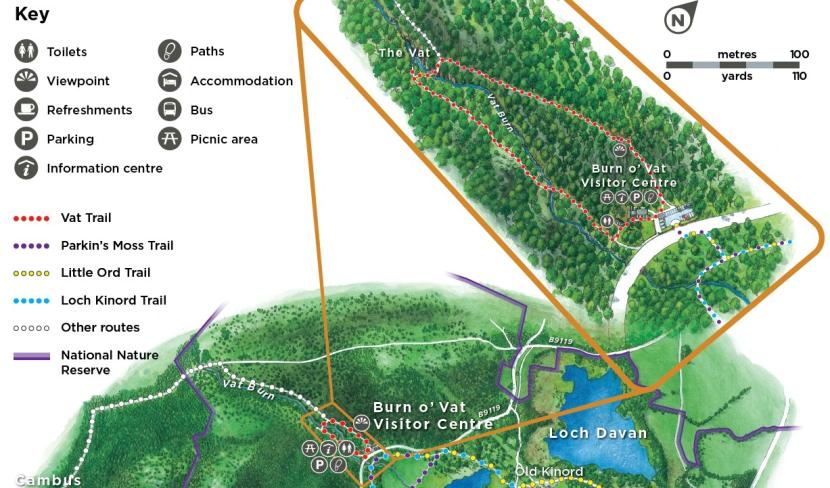Muir of Dinnet NNR - visiting the reserve leaflet
Welcome to Muir of Dinnet National Nature Reserve, managed by NatureScot
Four trails, all clearly marked, will help you explore. You choose whether you want a half-hour stroll, or a half-day’s walk round one of the lochs. Muir of Dinnet is one of the nine National Nature Reserves (NNRs) in and around the Cairngorms National Park.

Just at the edge of Dinnet village there’s a place where you can walk through some of Deeside’s prettiest woodland or picnic beside a loch covered in water lilies. And if you fancy scrambling into a granite cauldron, following in the footsteps of Queen Victoria, you can do that too!
The lochs are both leftovers from the last Ice Age. As the glaciers melted, two huge lumps of ice got stranded here: the lochs formed in the dents they left behind.
Plenty of light reaches the bottom of the shallow water, so the lochs are rich in plant life. Over 50 species of plant grow around the water’s edge. The reeds, rushes and willow trees make great shelter for nesting birds.
People have lived at Dinnet for thousands of years, leaving fascinating traces of their lives. One of Scotland’s most beautiful Pictish crosses, carved over 1,000 years ago, overlooks Loch Kinord.
Long before the cross was made, Iron Age people lived in a thriving village near New Kinord. See how many traces of their great huts you can find.
On Loch Kinord, one of the islands is actually a crannog: the remains of a hut built on a platform over the water. The other island once boasted a castle, visited by several Scottish kings.

The Reserve’s most spectacular feature is the Vat. It’s a vast bowl of pink granite, scooped out by a river flowing underneath the glaciers that covered the land about 20,000 years ago. Clambering inside is a real adventure. See if you can do it without getting your feet wet!
Beautiful woods have grown on the land shaped by the glaciers. Listen for birds like willow warblers in the spring, or watch for foraging flocks of tits in the winter. Around the edges of the reserve there are swathes of rare bearberry heath, while its bogs are home to colourful dragonflies and insect-eating plants like sundew.

The lochs are great places for birdwatching in winter. Teal, tufted duck and greylag geese all visit the reserve, and it’s one of the best places in Britain to see goldeneye. These dramatic looking birds used to be just winter visitors: now many pairs breed in Scotland. Dinnet’s lochs are perfect for them, with plenty of food and shelter. In early spring you might be lucky enough to see the males displaying, showing off their snowy white breasts and making a low, growling call as they try to impress the females.

Muir of Dinnet is 9.5km (6ml) east of Ballater on the A93. Turn north onto the B9119, signposted Tarland and Strathdon, and the Burn o’ Vat Visitor Centre is 2.5km (1.5ml) from the junction. Or set your sat nav for AB34 5NB. Contains Ordnance Survey data © Crown copyright and database right 2021
Need to know
Birds breed and raise young all over the reserve. If you bring a dog between April and July, please keep it on a short lead.

Find out more
- For more information please contact: Tel 01339 881667 or email [email protected]
- Support this NNR by making a donation.
- Follow @muirofdinnetNNR on social media and our blog: muirofdinnetnnr.wordpress.com
- Visiting the reserve, getting involved and about the reserve
- Visit more of our nature reserves
Reserve map

Key
- Toilets
- Viewpoint
- Refreshments
- Parking
- Information centre
- Paths
- Accommodation
- Bus
- Picnic area
Trails
The Vat Trail
Explore the woodland and scramble into the Vat – a huge granite cauldron formed by glaciers 20,000 years ago. Climb up to the viewpoint to learn about the Reserve and admire the lochs. For an easier, low-level option, you can follow the lower section of the path “there and back” to the Vat.
Parkin’s Moss Trail
Raised bogs are mysterious places where the ground is more water than solid earth. Find out what makes them so special – there’s a boardwalk to keep your feet dry!
Little Ord Trail
People have lived on the Reserve for thousands of years. On this trail you can explore some of the traces they’ve left behind, including a crannog and a beautiful Pictish cross.
Loch Kinord Trail
A circular route around the loch that takes you through Muir of Dinnet’s woodland, with beautiful views across the loch.





